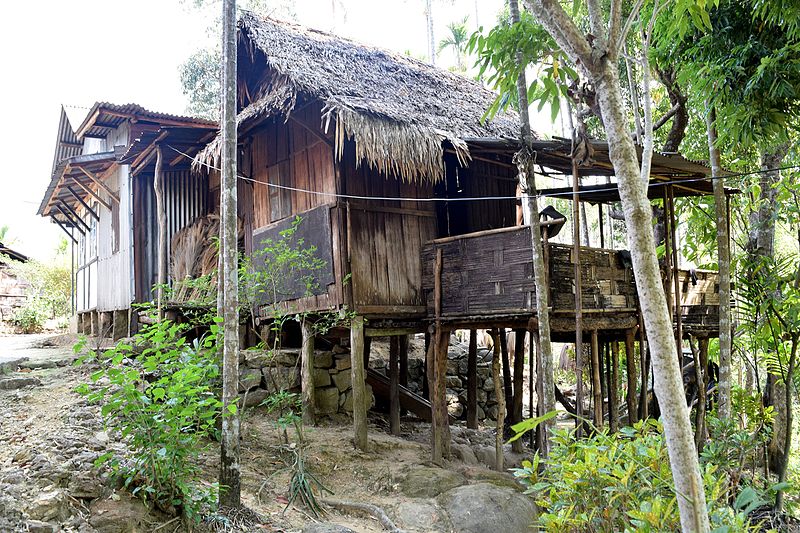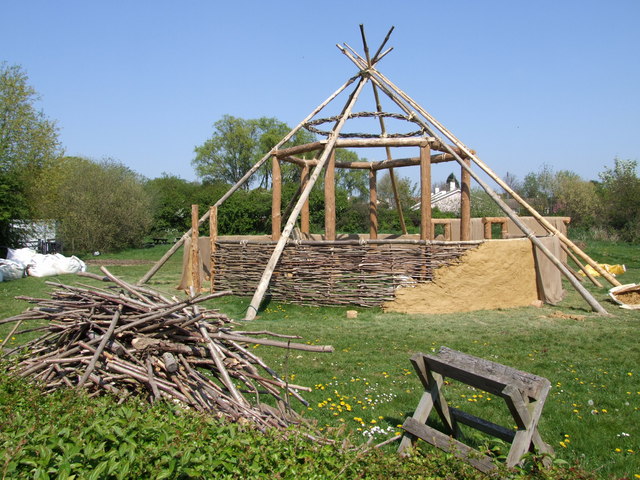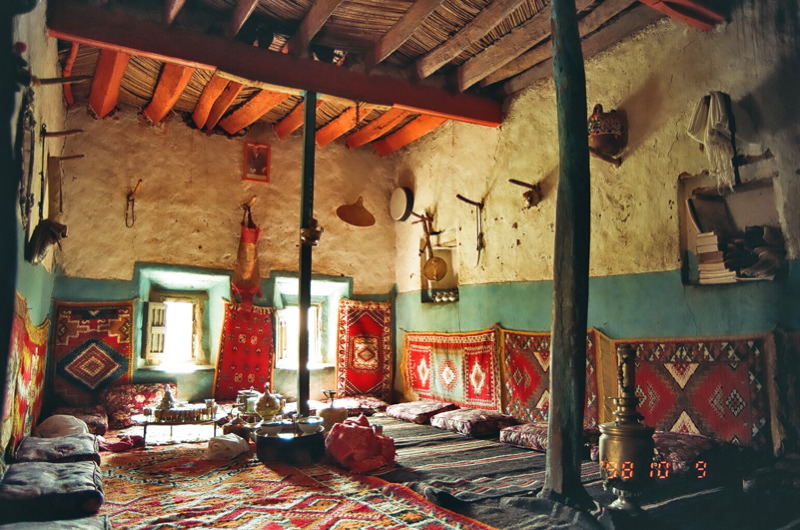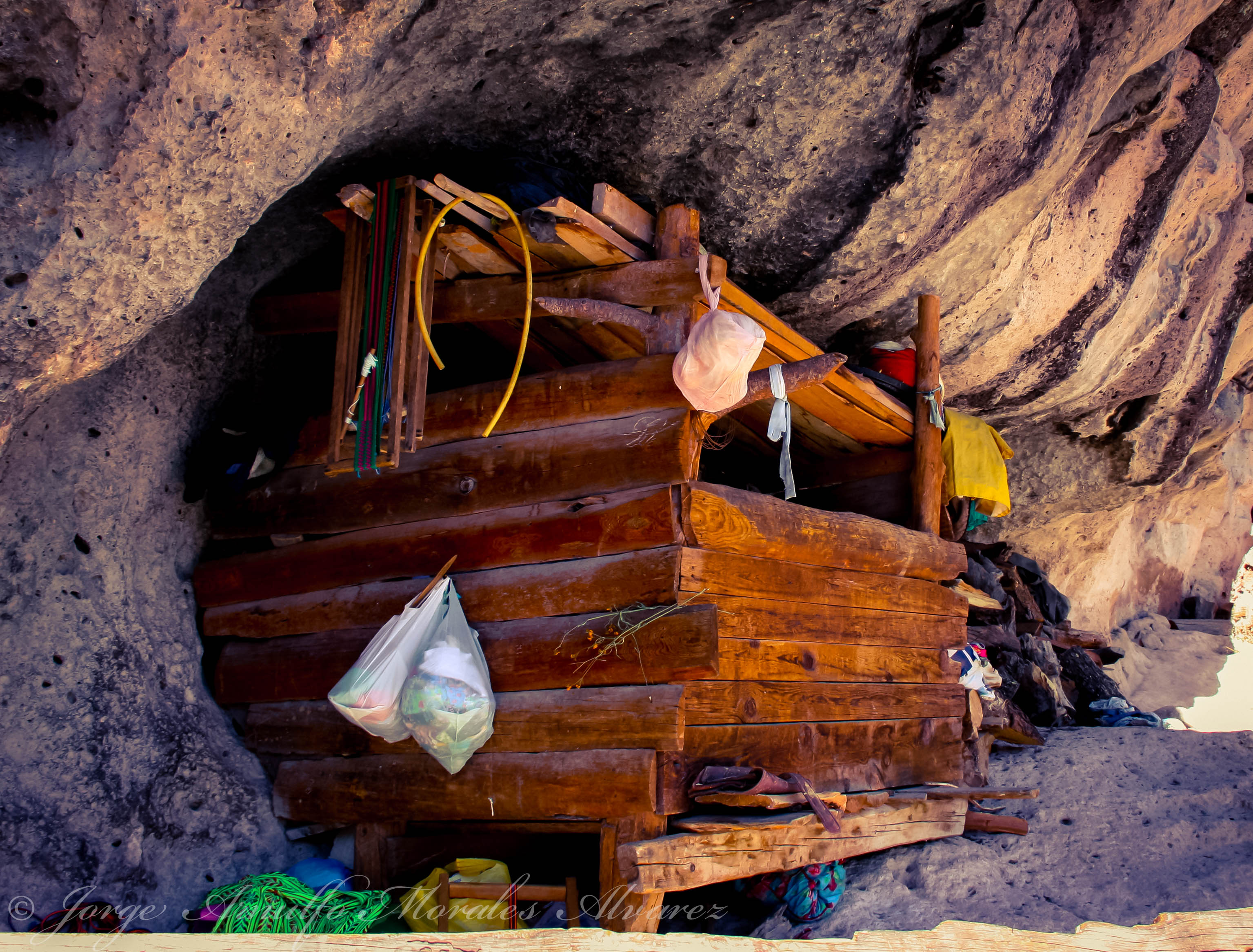
Traditional house at Mawlynnong, Meghalaya, India. Photo by Sujan Bandyopadhyay (CC BY-SA 4.0 via Wikimedia Commons)
People live and dwell within in a variety of constructed and unconstructed places that shape their existence. Dwellings vary enormously in their size, shape, and construction, and anthropological studies demonstrate that dwellings (and landscapes) dramatically shape human lives and historic identities. In size alone, dwellings can vary from small windbreak shelters to enormous longhouses that housing 24 or more families. Yet despite this variety, we can identify patterns in the way dwellings are constructed across and within societies Cross-cultural researchers find worldwide patterns in social organization and dwelling shape, size, and construction.
Construction and Function of Dwellings

Row of Maya houses in Chiapas. By Rod Waddington [CC BY-SA 2.0 (https://creativecommons.org/licenses/by-sa/2.0)], via Wikimedia Commons
In most societies, culture provides plans and general designs for building a house. For example, in ethnographic studies of contemporary Tzeltal communities, Brian Stross described the eight steps that Maya people use to make available local materials into the typical and traditional square shaped dwellings (1998:34). In order, these steps include measuring the home foundation, leveling the foundation, gathering, cutting, and placing framing posts, gathering thatch and weaving it into a roof, making a drainage ditch, cutting and placing siding boards, and finally constructing and installing a door. The materials include local clay, small trees acting as poles, rope, vines, grasses or palms for roofing.
Aside from the labor involved in putting the materials together, it takes time to gather materials from the environment and to organize and manage labor arrangements throughout the building process. Robert Redfield reported that it took 16 to 63 days to build a house in the 1930s (Wauchope 1938:140 referring to Redfield). In the Maya regions, the act of house construction is primarily a male duty. Men learn how build dwellings at a young age, helping in other men’s construction projects through which they learn how to build a house of their own someday (Wauchope 1938:140).
Beyond materials and construction methods, the form and function of dwellings greatly differ all over the world. Cross-cultural research demonstrates that square-shaped dwelling spaces (such as those built by the Tzeltal) are usually found in more complex sedentary societies (Whiting and Ayres 1968, 123–4; Robbins 1966, 11–15, 148–9). This certainly rings true in the case of Maya society, where larger communities and permanent, agricultural settlements have been the norm in times past and present.

“Reconstructing an Iron Age Roundhouse.” Photo of a partially reconstructed roundhouse from the Iron Age in Hadleigh Country Park, UK. by Gary Faux (CC BY-SA 2.0 via Wikimedia Commons)
Research also shows that smaller, less hierarchical societies such as hunter-gatherers are more likely to build and live within circular dwelling structures. Subsisting off of a diet of local salmon, wild game, fruits, and roots, in the summer the Yahi people of Northern California built small round houses called wawi or wowi out of lightweight materials. Built out of bent and interwoven branches, sticks, and small logs, these buildings were easy to move and build in a short amount of time. This form of dwelling enabled the Yahi people to range throughout the mountains in the summer months while still providing shelter (Kroeber: 1976).
Along with the differences mentioned above, the functional space that dwellings provide differs greatly from society to society. The Yahi dwelling would only be able to provide shelter for a small family or a few individuals whereas the Maya dwelling could potentially host several families. Dwellings and the remains of dwellings therefore can be a good way for archaeologists or cultural anthropologists to estimate a given population’s size. More specifically, when compiled, a dwelling floor area can be used by archaeologists to infer the size of a population at a site (Naroll 1962, 588; Brown 1987, 31–32). Most North Americans would be surprised that the worldwide average is only 6 square meters (about 20 square feet) per person. Estimating a population in this manner requires research to account for different types of architecture, seasonal change, residential and non-residential space. See Explaining Human Cultures’ module on Dwellings for more cross-cultural findings.
Symbolism of Dwellings

Interior of a Morrocan Berber Home in Marrakech, Maroc. Photo By Ilan Molcho 2007 (CC BY 2.0 via Wikimedia Commons)
Cross-cultural researchers have concentrated on the size, shape, and building materials in looking for patterns across cultures but as yet have paid relatively little attention to the symbolic meanings of dwellings. But symbolic meaning has been explored through ethnography.
Pierre Bourdieu’s seminal study of the Berber (Kablye) House (1970) focused on characterizing how the symbolic elements of dwelling space was symbolically organized and reflected social beliefs about male and female relationships. For example, Bourdieu found that the Berber people divided dwelling space between light and dark (135-136):
“The dark, nocturnal, lower part of the house, the place for things that are damp, green, or raw -kars of water placed on the benches on either side of the stable entrance or next to the wall of darkness, wood, green fodder – and also the place for natural beings – oxen and cows, donkeys and mules – natural activities – sleep, sexual intercourse, childbirth, and also death – is opposed, as nature to culture, to the light-filled, noble, upper part: this is the place for human beings and especially for the quest, for fire and objects made with fires, such as the lamp, kitchen utensils, the rifle – a symbol of the male point of honour (nif) which protects female honour (hurma) – the loom, the symbol of all protection; and it is also the site of two specifically cultural activities performed within the house, weaving and cooking.”
Bourdieu argued that these divisions of dwelling space were oppositional (136) relationships wherein each symbolic element is an index that establishes the relationships between light and dark. This helps each symbol gain meaning from opposition between lightness and darkness. Bourdieu concluded that the Berber people divided their dwelling spaces to mirror their cosmological beliefs. As found in eHRAF World Cultures, earlier researcher Edward Westermarck noted other important cosmological symbolism in Berber dwelling space. He noted beliefs regarding the “haunted” threshold of the home and detailed how spirits called “masters of the house” shaped social action. Describing the beliefs he encountered, Westermark noted that the Berber people believed “house spirits” were extremely powerful – “If the masters of the house are good the inhabitants will prosper, if bad they will have misfortunes or soon die.”
Dwelling in Landscapes of the Tarahumara

Authentic Raráumuri Home in Chihuahua, Mexico. Photo by Jorge Arnulfo Morales Alvarez 2014 (CC BY 2.0 via Flickr).
One of the most important shifts in studying human dwellings came from British anthropologist Timothy Ingold (2000). He argued that anthropologists had come to study dwellings as “symbolic webs of meaning” without contextualizing dwelling spaces within “natural landscapes.” Ingold argued that when building, living within, and abandoning dwellings, the actions of people are shaped by their interaction with tools, resources, and the landscape itself. Ingold’s approach, which he called “the dwelling perspective,” played a pivotal role in the development of cultural anthropology and archaeological landscape studies that contextualize human dwelling within broader landscapes.
The Tarahumara or Rarámuri people of Northern Mexico traditionally build and live within cave-like cliff shelters built from stone, wood, and other local resources. Without distinguishing indoor or outdoor space, the Tarahumara people create and maintain spiritual relationships with the landscape by building into cave-like rock shelters with patio areas for religious dances (Kennedy 1978). Given the Tarahumara’s deep connection to the landscape, a landscape approach that contextualizes built architecture with the landscape provides the most insight.
Found in eHRAF World Cultures, early research by Carl Lumholtz indicates that experience of dwelling within the “natural” landscape powerfully shapes how the Tarahumara choose occupation sites. He writes: “A never absent feature of the Tarahumara habitation, be it house or cave, is a level, smooth place in front of it. This is the dancing place, or patio, on which he performs his religious exercises, and he may have more than one. The formation of the land may even oblige him to build terraces to obtain space enough for his religious dances (p. 171).” Discussing the religious patio space attached to every dwelling, Lumholtz noted that Tarahumara patios featured wooden religious crosses. Rather than constructed, these wooden crosses were actually cultivated elements of the natural landscape. Describing these crosses, Lumholtz noted “I saw two crosses raised outside of a man’s house, which were formed by the natural growth of small pine trees, and these were four feet high.” In sum, for the Tarahumara the landscape 1) plays a large role in helping the Tarahumara choose a location for each dwelling and 2) plays a large role in the organization and creation of smaller features within each dwelling space. This helps demonstrate that Tarahumara dwelling space emerges from a dynamic relationship between humans and nature.
Human dwellings can be incredible sources of information about human culture past and present. The functional, symbolic, or landscape approaches described here have potential benefits and drawbacks while providing different perspectives of human dwelling. Research objectives should help the anthropologists to determine which approach is best for studying dwelling space. The eHRAF World Cultures database provides the data to explore dwellings using each these approaches and much more.
JEFFREY VADALA / 15 MARCH 2018
References
Bourdieu, Pierre. 1970. “The Berber house or the world reversed.” Social Science Information Volume 9.2:151-170.
Brown, Barton M. 1987. “Population Estimation From Floor Area: A Study of ‘Naroll’s Constant.’” Behavior Science Research 21 (1-4): 1–49. doi:10.1177/106939718702100101.
Ingold, T., 2000. The perception of the environment: essays on livelihood, dwelling and skill. Psychology Press. London, U.K.
Kennedy, J.G., 1978. “Tarahumara of the Sierra Madre; beer, ecology and social organization.” AHM. Arlington Heights, IL.
Kroeber, A (1976). Handbook of the Indians of California. New York: Dover Publications.
Lumholtz, Carl. 1902. “Unknown Mexico: A Record Of Five Years Exploration Of The Western Sierra Madre ; In The Tierra Caliente Of Tepic And Jalisco ; And Among The Tarascos Of Michoacan” Vol. 1. New York: Charles Scribners’ Sons. http://ehrafworldcultures.yale.edu/document?id=nu33-002
Naroll, Raoul. 1962. “Floor Area and Settlement Population.” American Antiquity 27 (4): 587–89. doi:10.2307/277689.
Redfield, R. and Villa Rojas, A., 1962. Chan Kom: A Maya village. Carnegie Institution of Washington Publication 448.
Robbins, Michael C. 1966. “House Types and Settlement Patterns: An Application of Ethnology to Archaeological Interpretation.” Minnesota Archaeologist 28 (1): 3–35.
Stross, B., 1998. Seven ingredients in Mesoamerican ensoulment: dedication and termination in Tenejapa. The sowing and the dawning: Termination, dedication, and transformation in the archaeological and ethnographic record of Mesoamerica, pp.31-9
Wauchope, R., 1938. Modern Maya houses: A study of their archaeological significance (No. 502). Carnegie institution of Washington.
Whiting, John W., and Barbara Ayres. 1968. “Inferences from the Shape of Dwellings.” In Settlement Archaeology, edited by Kwang-chih Chang. Palo Alto, CA: National Press Books.